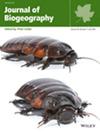Phyloregions in American Mammals: Contrasting Biogeographical Patterns With the Evolutionary Histories of Lineages
Abstract
Aim
To compare mammal phylogenetic regionalisation with previous biogeographical maps obtained from the distributional overlap of endemic taxa, considering evolutionary affinities and phylogenetic uniqueness. To test whether there is correspondence between areas of endemism at different spatial scales and phyloregions, driven by unique species or phylogenetic lineages.
Location
The Americas.
Taxon
Terrestrial mammals.
Methods
Distributional and phylogenetic data on 1782 mammal species of the Americas were used to identify spatial patterns in phylogenetic turnover (pβsim), which led to significant clustering of grid cells (phyloregions) to be compared with traditional biogeographical units. Evolutionary Correspondence Analysis (evoCA) was applied to reveal significant evolutionary divergences among phyloregions, driven by unique species or phylogenetic lineages.
Results
High explained variance in phylogenetic turnover confirmed robust phyloregions throughout all the analyses performed. Eight distinct phyloregions emerged from all mammals analysed together, but particular mammal lineages showed unique phyloregions. The eight phyloregions clustered into major biogeographical units based on evolutionary affinities, confirming known biogeographical patterns. We found notable evolutionary affinities within the Nearctic, Neotropical, and Andean regions. A complex pattern of overlapping boundaries at the Mexican Transition Zone marked biogeographical transitions between the Nearctic and Neotropical regions. Smooth boundary transitions occurred in the South American Transition Zone between the Neotropical and Andean regions. The evoCA revealed a significant evolutionary divergence between the Antillean and continental phyloregions, primarily driven by unique species. Continental regionalisation was shaped by more complex patterns of variation in phylogenetic composition, rather than being dominated by a few dominant species or lineages.
Main Conclusion
Phylogenetic regionalization, both considering all the taxa together and particular lineages, is a useful tool for biogeography and conservation biology. Contrasting this approach with traditional biogeographical regionalization allows a more nuanced understanding of evolutionary processes and historical events that shape variation in the composition of mammal assemblages and current biodiversity patterns.

 求助内容:
求助内容: 应助结果提醒方式:
应助结果提醒方式:


